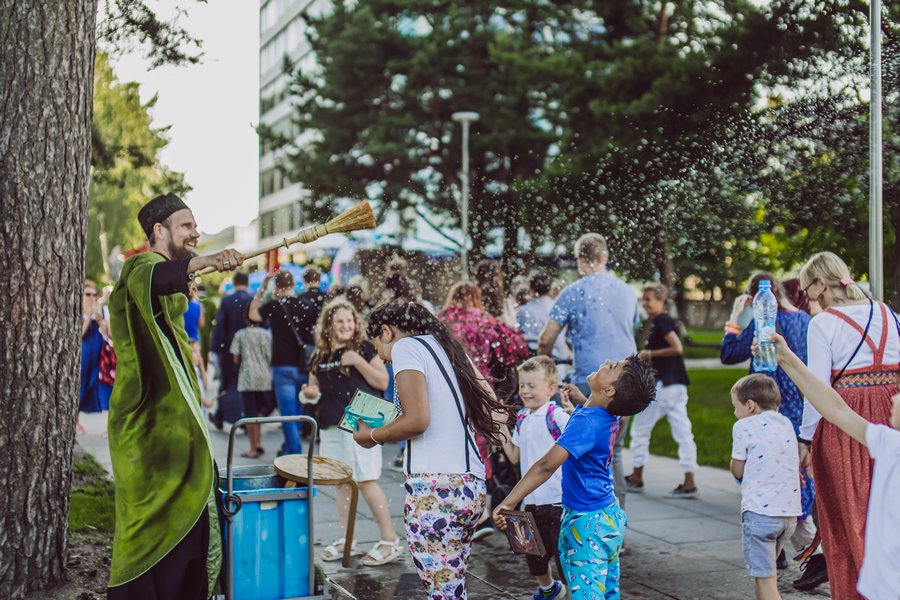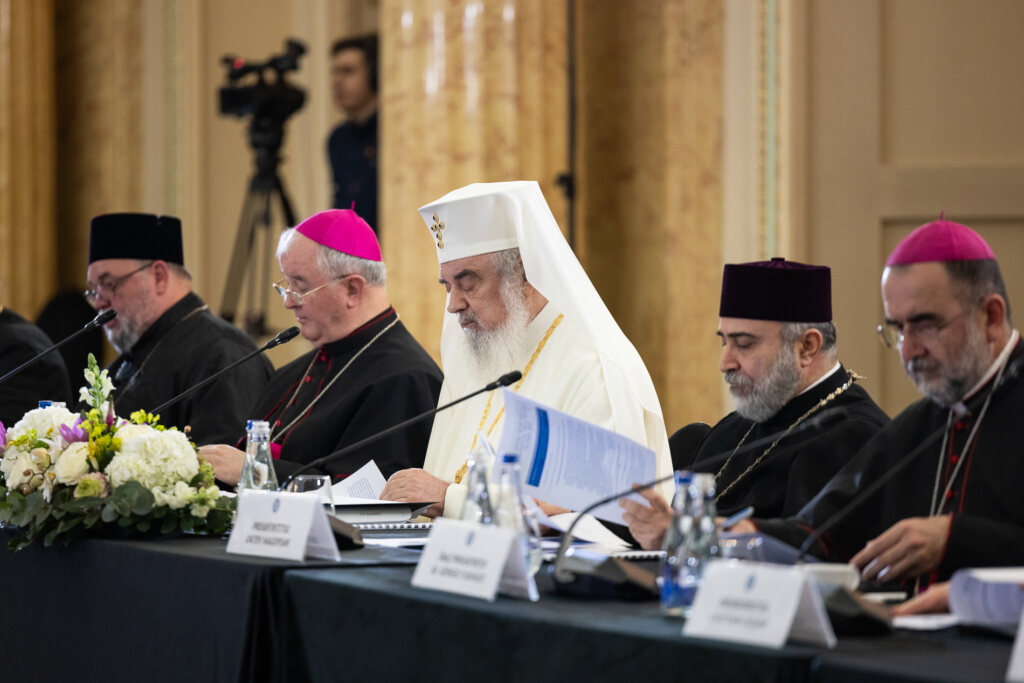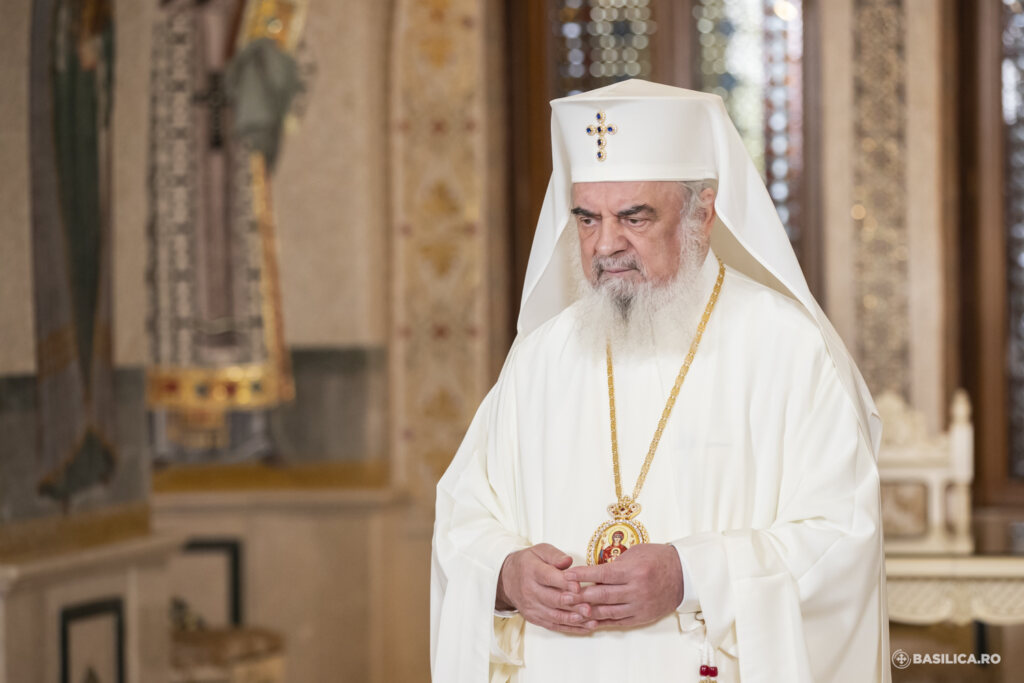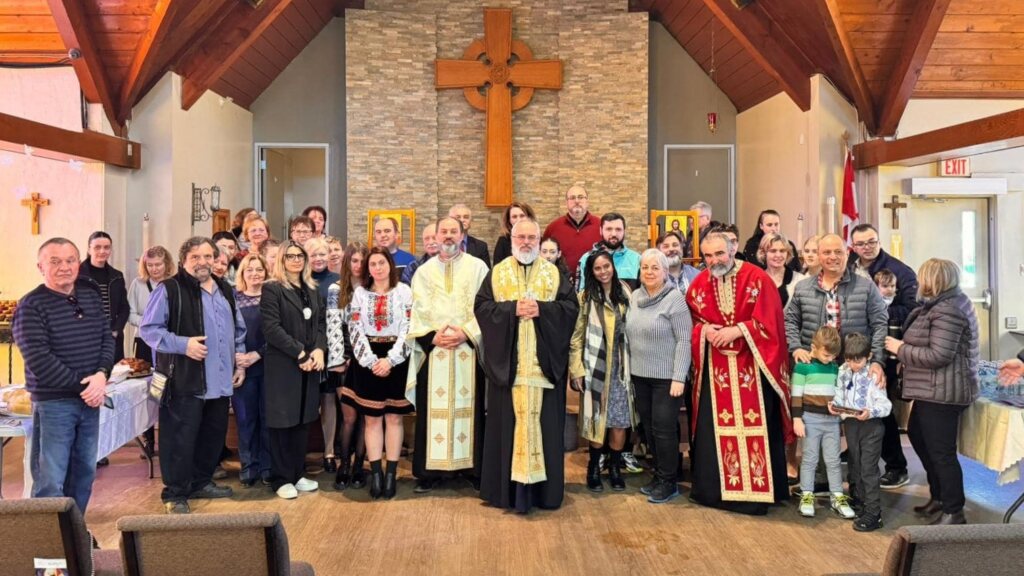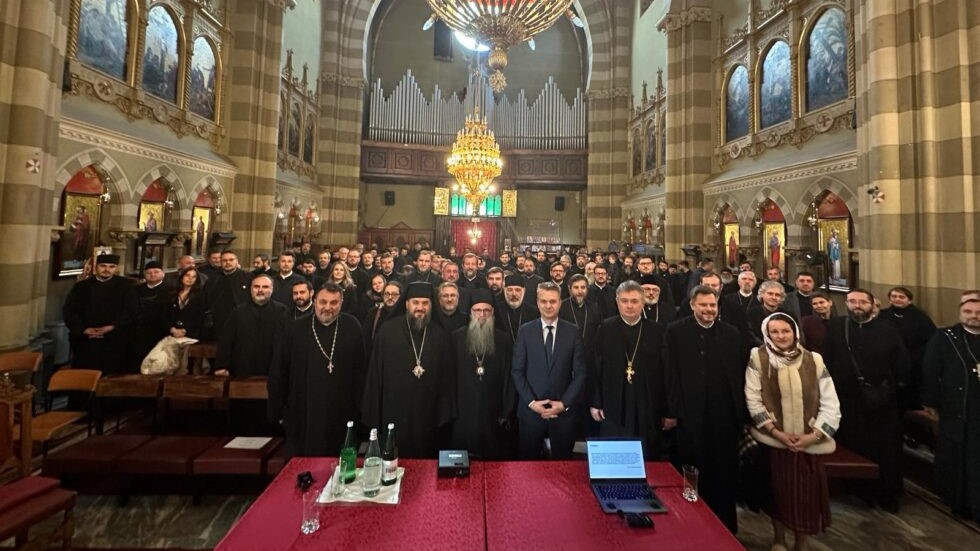The Protection of the Most Holy Theotokos
The Protection of the Most Holy Theotokos: “Today the Virgin stands in the midst of the Church, and with choirs of Saints she invisibly prays to God for us. Angels and Bishops venerate Her, Apostles and prophets rejoice together, Since for our sake she prays to the Eternal God!”
This miraculous appearance of the Mother of God occurred in the mid-tenth century in Constantinople, in the Blachernae church where her robe, veil, and part of her belt were preserved after being transferred from Palestine in the fifth century.
On Sunday, October 1, during the All Night Vigil, when the church was overflowing with those at prayer, the Fool-for-Christ Saint Andrew (October 2), at the fourth hour, lifted up his eyes towards the heavens and beheld our most Holy Lady Theotokos coming through the air, resplendent with heavenly light and surrounded by an assembly of the Saints.
Saint John the Baptist and the holy Apostle John the Theologian accompanied the Queen of Heaven. On bended knees the Most Holy Virgin tearfully prayed for Christians for a long time. Then, coming near the Bishop’s Throne, she continued her prayer.
After completing her prayer she took her veil and spread it over the people praying in church, protecting them from enemies both visible and invisible. The Most Holy Lady Theotokos was resplendent with heavenly glory, and the protecting veil in her hands gleamed “more than the rays of the sun.”
Saint Andrew gazed trembling at the miraculous vision and he asked his disciple, the blessed Epiphanius standing beside him, “Do you see, brother, the Holy Theotokos, praying for all the world?” Epiphanius answered, “I do see, holy Father, and I am in awe.”
The Ever-Blessed Mother of God implored the Lord Jesus Christ to accept the prayers of all the people calling on His Most Holy Name, and to respond speedily to her intercession, “O Heavenly King, accept all those who pray to You and call on my name for help. Do not let them go away from my icon unheard.”
Saints Andrew and Epiphanius were worthy to see the Mother of God at prayer, and “for a long time observed the Protecting Veil spread over the people and shining with flashes of glory. As long as the Most Holy Theotokos was there, the Protecting Veil was also visible, but with her departure it also became invisible. After taking it with her, she left behind the grace of her visitation.”
At the Blachernae church, the memory of the miraculous appearance of the Mother of God was remembered. In the fourteenth century, the Russian pilgrim and clerk Alexander, saw in the church an icon of the Most Holy Theotokos praying for the world, depicting Saint Andrew in contemplation of her.
The Primary Chronicle of Saint Nestor reflects that the protective intercession of the Mother of God was needed because an attack of a large pagan Russian fleet under the leadership of Askole and Dir.
The feast celebrates the divine destruction of the fleet which threatened Constantinople itself, sometime in the years 864-867 or according to the Russian historian Vasiliev, on June 18, 860. Ironically, this Feast is considered important by the Slavic Churches but not by the Greeks.
The Primary Chronicle of Saint Nestor also notes the miraculous deliverance followed an all-night Vigil and the dipping of the garment of the Mother of God into the waters of the sea at the Blachernae church, but does not mention Saints Andrew and Epiphanius and their vision of the Mother of God at prayer.
These latter elements, and the beginnings of the celebrating of the Feast of the Protection, seem to postdate Saint Nestor and the Chronicle. A further historical complication might be noted under (October 2) dating Saint Andrew’s death to the year 936.
The year of death might not be quite reliable, or the assertion that he survived to a ripe old age after the vision of his youth, or that his vision involved some later pagan Russian raid which met with the same fate.
The suggestion that Saint Andrew was a Slav (or a Scythian according to other sources, such as S. V. Bulgakov) is interesting, but not necessarily accurate. The extent of Slavic expansion and repopulation into Greece is the topic of scholarly disputes.
In the PROLOGUE, a Russian book of the twelfth century, a description of the establishment of the special Feast marking this event states, “For when we heard, we realized how wondrous and merciful was the vision… and it transpired that Your holy Protection should not remain without festal celebration, O Ever-Blessed One!”
Therefore, in the festal celebration of the Protection of the Mother of God, the Russian Church sings, “With the choirs of the Angels, O Sovereign Lady, with the venerable and glorious prophets, with the First-Ranked Apostles and with the Hieromartyrs and Hierarchs, pray for us sinners, glorifying the Feast of your Protection in the Russian Land.”
Moreover, it would seem that Saint Andrew, contemplating the miraculous vision was a Slav, was taken captive, and became the slave of the local inhabitant of Constantinople named Theognostus.
Churches in honor of the Protection of the Mother of God began to appear in Russia in the twelfth century. Widely known for its architectural merit is the temple of the Protection at Nerl, which was built in the year 1165 by holy Prince Andrew Bogoliubsky.
The efforts of this holy prince also established in the Russian Church the Feast of the Protection of the Mother of God, about the year 1164.
At Novgorod in the twelfth century there was a monastery of the Protection of the Most Holy Theotokos (the so-called Zverin monastery) In Moscow also under Tsar Ivan the Terrible the cathedral of the Protection of the Mother of God was built at the church of the Holy Trinity (known as the church of Saint Basil the Blessed).
On the Feast of the Protection of the Most Holy Theotokos we implore the defense and assistance of the Queen of Heaven, “Remember us in your prayers, O Lady Virgin Mother of God, that we not perish by the increase of our sins. Protect us from every evil and from grievous woes, for in you do we hope, and venerating the Feast of your Protection, we magnify you.”
Troparion – Tone 4:
Today the faithful celebrate the feast with joy illumined by your coming, O Mother of God. Beholding your pure image we fervently cry to you: “Encompass us beneath the precious veil of your protection; deliver us from every form of evil by entreating Christ, your Son and our God that He may save our souls.”

The Holy Apostle Ananias
The Holy Apostle Ananias of the Seventy was the first Bishop of Damascus. The Lord ordered him to restore the sight of Saul, the former persecutor of Christians, then baptize him (Acts 9:10-19, 22:12).
Saul became the great preacher and Apostle Paul. Saint Ananias boldly and openly confessed Christianity before the Jews and the pagans, despite the danger.
From Damascus he went to preach at Eleutheropolis, where he healed many of their infirmities. Lucian, the prefect of the city, tried to persuade the holy one to offer sacrifice to idols. Because of Ananias’ staunch and solid confession of Christ, Lucian ordered that he be tortured.
Harsh torments did not sway the witness of Truth. Then the torturers led him out beyond the city, where they stoned him. The saint prayed for those who put him to death. His relics were later transferred to Constantinople.

Saint Romanus the Melodist
Saint Romanus the Melodist was born in the fifth century in the Syrian city of Emesa of Jewish parents. After moving to Constantinople, he became a church sacristan in the temple of Hagia Sophia. The monk spent his nights alone at prayer in a field or in the Blachernae church beyond the city.
Saint Romanus was not a talented reader or singer. Once, on the eve of the Nativity of Christ, he read the kathisma verses. He read so poorly that another reader had to take his place. The clergy ridiculed Romanus, which devastated him.
On the day of the Nativity, the Mother of God appeared to the grief-stricken youth in a vision while he was praying before her Kyriotissa icon. She gave him a scroll and commanded him to eat it. Thus was he given the gift of understanding, composition, and hymnography.
That evening at the all-night Vigil Saint Romanus sang, in a wondrous voice, his first Kontakion: “Today the Virgin gives birth to the Transcendent One…” All the hymns of Saint Romanus became known as kontakia, in reference to the Virgin’s scroll.
Saint Romanus was also the first to write in the form of the Oikos, which he incorporated into the all-night Vigil at his places of residence (In Greek, “oikos”).
For his zealous service Saint Romanus was ordained as a deacon and became a teacher of song. Until his death, which occurred about the year 556, the hierodeacon Romanus the Melodist composed nearly a thousand hymns, many of which are still used by Christians to glorify the Lord. About eighty survive.
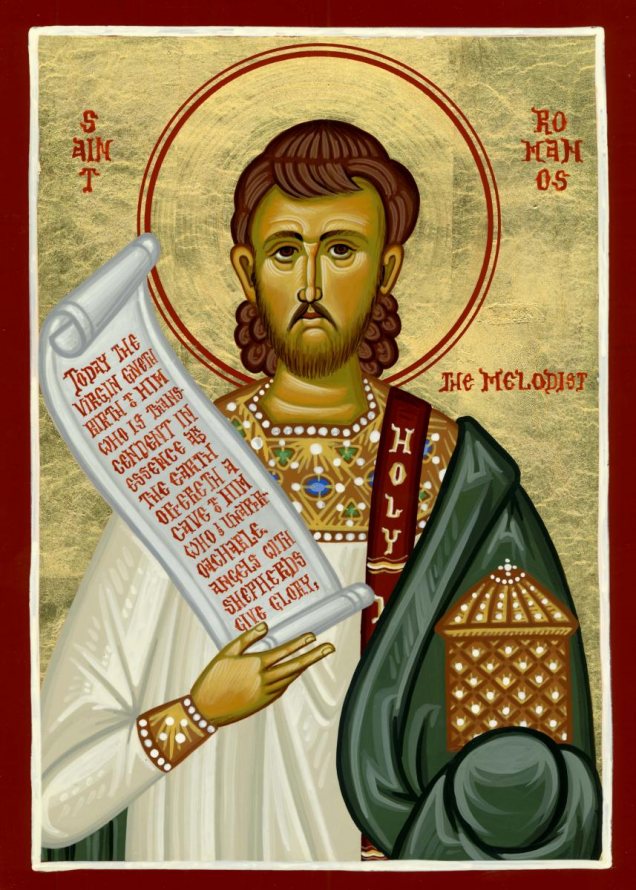
Venerable Joseph from Bisericani
Venerable Joseph from Bisericani was born in a village in Neamţ region, in the 15th century. He wished to join the monastic life since he was young, so that he joined the community of Bistriţa Monastery.
He was tonsured in monasticism there and learned the spiritual life, fasting and permanent prayer from the old fathers. Later on, Venerable Joseph received his igumen’s blessing to go to pray at the Holy Sepulchre in Jerusalem. Then, he retired into the desert in the Jordan Valley where he became a famous hermit in only a few years.
There he lived in a cave, first alone, and then with a few disciples, suffering many temptations from the evil one. He lived a life of great spirituality and gathered 17 hermits around him, setting up the first Romanian monastic community in the Holy Land.
But, after the Arabs invaded the Holy Places causing much turmoil, Venerable Joseph took his disciples and went to Moldavia, to Bistriţa Monastery. Thus, Joseph’s hermitage moved from the Jordan Valley to Moldavia, to Bisericani Mount.
After the number of disciples grew, he raised a small church dedicated to the Annunciation, building also cells around it. He settled the akoimati (sleepless) order for the monastic community over there, according to the model of the Studites’ Monastery of Constantinople, which meant permanent prayer in the church and cells, fasting, bowing, psalm singing and obedience.
When the Turks invaded the country burning down the church, the monks decided to leave for the Holy Mount Athos. But the Holy Mother of God appeared on their way to Athos in an oak tree and asked them: “Where are you going?”. When they saw this wonderful sight, they said: “We are going to your garden!”.
Then, the Mother of God told them: “Go back, because this is my garden too!”. They put an icon of the Mother of God at that place in the memory of this miracle. Later on, the Skete of Venerable Joseph was called “Bisericani Skete”, namely of those who always prayed in the church, because the monks were praying day and night, with tears in their eyes and many faithful were healed of diseases, through the prayer and blessing of Venerable Joseph.
Thus, he piously lived to an old age, made miracles and passed away in peace.
Venerable Kyriakos from Bisericani
Venerable Kyriakos from Bisericani lived as a monk at the beginning of the 17th century at Bisericani Monastery, which numbered over 100 monks at the time. He retreated in wilderness, into a cave of Mount Simon, where he lived alone in austere conditions, for 60 years.
He was staying in the mountains, in summer and winter, without proper clothing, in pure prayer, overcoming with the power of Christ the helplessness of nature and temptation of the devil.
Saint Hierarch Dosoftei, metropolitan of Moldavia, had met Venerable Kyriakos and, later on, after he fell asleep into the Lord he venerated his holy relics in the cave where he had lived, a cave that can still be seen today and where a chapel was raised in his honour.
Given their holy lives, on 6 March 2008, the Holy Synod of the Romanian Orthodox Church canonised Venerables Joseph and Kyriakos, being celebrated on 1 October.
Through their holy prayers, Christ, our God, have mercy on us. Amen.
Troparion – Tone 1:
Advisors of the hermits, protectors of those in need and comforters of the saddened, oh, Pious Saints Joseph and Kyriakos, as the ones who achieved the fiery prayer and became chosen vessels of the Holy Spirit, pray to God to grant our souls peace and great mercy!

19th Sunday after Pentecost
Scripture Reading (Luke 6:31-36)
And just as you want men to do to you, you also do to them likewise. But if you love those who love you, what credit is that to you? For even sinners love those who love them. And if you do good to those who do good to you, what credit is that to you? For even sinners do the same. And if you lend to those from whom you hope to receive back, what credit is that to you? For even sinners lend to sinners to receive as much back. But love your enemies, do good, and lend, hoping for nothing in return; and your reward will be great, and you will be sons of the Most High. For He is kind to the unthankful and evil. Therefore be merciful, just as your Father also is merciful.


